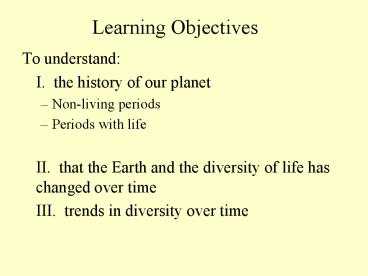Learning Objectives - PowerPoint PPT Presentation
Title:
Learning Objectives
Description:
II. that the Earth and the diversity of life has changed over time ... Reptiles = snakes, lizards, crocs. Gymnosperms = pines, spruce, fir, larch ... – PowerPoint PPT presentation
Number of Views:55
Avg rating:3.0/5.0
Title: Learning Objectives
1
Learning Objectives
- To understand
- I. the history of our planet
- Non-living periods
- Periods with life
- II. that the Earth and the diversity of life
has changed over time - III. trends in diversity over time
2
Early Earth
- Earth began forming 4.5 bya
- Evidence
- 1st atmosphere N2, H2, CO and CO2
- no O2 or ozone, high UV winds
- H2O was present
3
- Experiments mimicking conditions on early earth
demonstrate that organic compounds can form from
inorganic compounds - Amino acids, nucleotides, carbs, ATP, NAD(P)
- Phospholipid bubbles provide structure for a
cell
4
First Life
- Prokaryotes originated 3.8 bya in Archean
proliferated through Proterozoic - Chemoautotrophs made carbohydrates using
chemicals in environment - non-oxygen releasing
released sulfur - Oxygen releasing photosyn. arose later
(photoautotrophs) - Breakdown of carbohydrates to ATP did not req
oxygen at first (fermentation), but later
organisms use O2
5
- Photosynthesis 3.2 bya
- Effects of oxygen
- Mass extinction of many organisms
- Prokaryotic diversity of a different kind starts
to diversify - ozone layer develops 2 bya
6
Origin of eukaryotic cells
- 1 bya
- Endosymbiosis
- partnerships between prokaryotic ancestors
- chloroplasts and mitochondria
- Evidence?
7
youngest
oldest
- Archean
- prokarys. only
- Proterozoic
- Paleozoic
- Mesozoic
- Cenozoic
youngest
oldest
8
Paleozoic
- Started with mass extinction, then adaptive
radiation of multicellular organisms - Life proliferated in seas
- Cambrian explosion of inverts
- Armored fish follow
- Then land invasion plants,
- insects, amphibians
9
Mesozoic
- Adaptive radiation of seed
- bearing plants and reptiles
- followed by mass extinction
10
Cenozoic
- Adaptive radiation of mammals
- H. sapiens evolved in last 40,000 yrs.
Agriculture arose 10,000 yrs. - Average extinction rates
- 1 spp./1 million spp./year
- 20th century extinction rates
- 1,000 -10,000 spp. / 1 million spp. / year
11
Biodiversity
- Millions of species now on earth (2 million)
- Diversity has changed radically over time
- Observations - Many species look like other
species - Broad similarities lineages with similar
phenotypes life histories - Reptiles snakes, lizards, crocs
- Gymnosperms pines, spruce, fir, larch
- Primates great apes, chimps, humans
- Within a very closely related group, the
different species of the group tend to live in
different habitats - White Pine and Jack Pine and tamarack live in
different habitats - Great apes (baboons, gorillas, orangutans) live
in different habitats
12
Conclusions
- Broad similarities in life histories are present
because lineages are related - Supported by initially by studies of anatomy,
development, and now by molecular data - Similar species in different habitats exist b/c
each habitat selects for traits in slightly
different ways
13
- Taxonomy classifies organisms to reflect
relatedness. - Taxon - a group of organisms with similar form(s)
that are related. - Reptiles are a taxonomic group
- Gymnosperms are a taxonomic group
- Then, all of the pines (white, red, limber,
lodgepole, etc) are another more specific
taxonomic group. All pines are closely related.
14
Classification system
- developed by Linnaeus (1758)
- hierarchial organization
- binomial species name
- genus and epithet species
- Used to identify organisms
15
- Species belong to a genus (1st part of name)
- Genera grouped into families
- Families grouped into orders
- Orders -- classes
- Classes -- Phyla
- Phyla
- Kingdoms 6 kingdoms
- Domains are the largest unit
- Eukarya, Bacteria, Archaea
Domain
Eukarya































